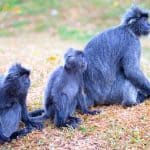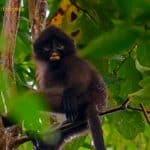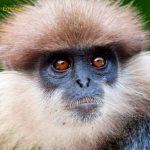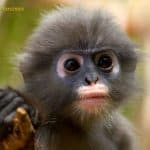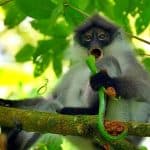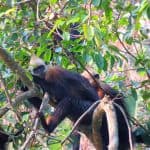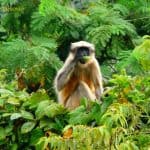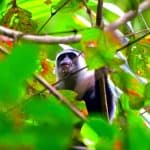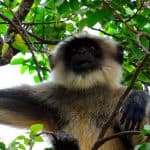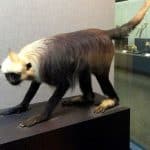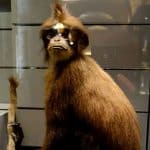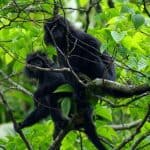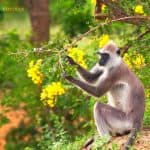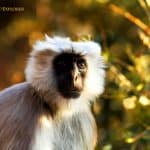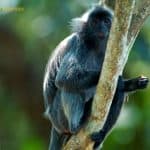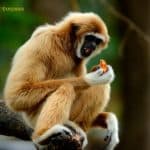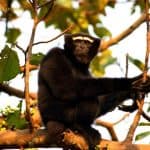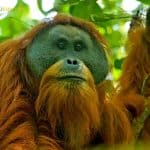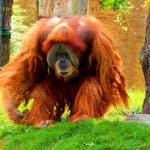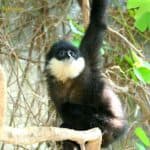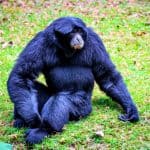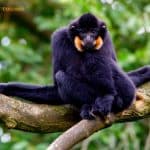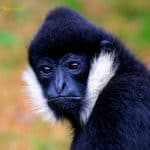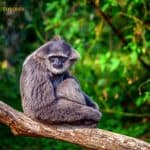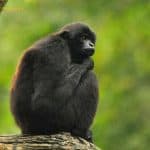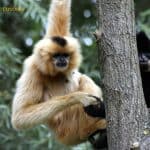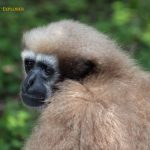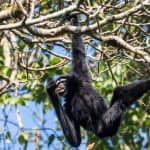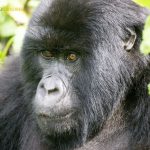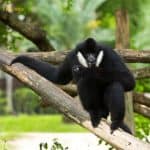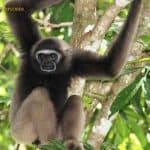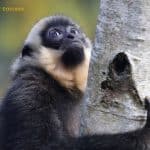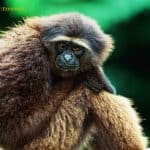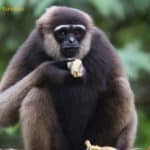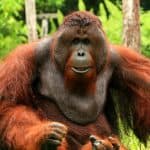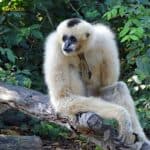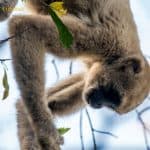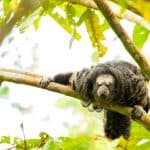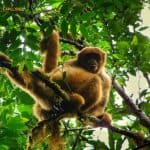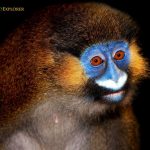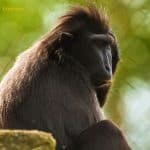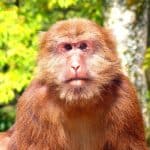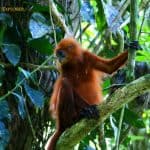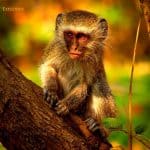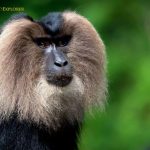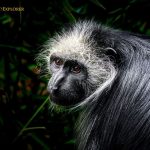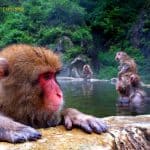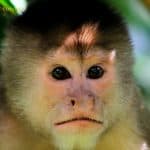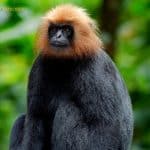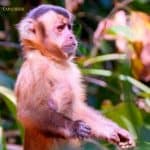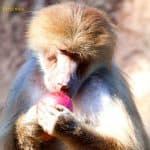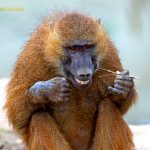Monkey - search results
If you're not happy with the results, please do another search
Langurs
Langurs are Old-world monkeys classified under the Colobinae family along with other leaf-eating monkeys, including Colobus and proboscis monkeys. Explore langur characteristics and all types of langur species here.
Selangor Silvered Langur
The Selangor silvered langur (Trachypithecus selangorensis) is a leaf monkey living on the west coast of the Malay Peninsula. Like most leaf monkeys, the Selangor silvered langur usually lives in groups of a single adult male and several adult females and their young offspring.
Robinson’s Banded Langur
Robinson's banded langur (Presbytis robinsoni), also known as Robinson's banded surili, is a monkey species in the Cercopithecidae family. Robinson Banded Langurs are generally shy and alert creatures, rarely leaving the comfort of the canopy.
Purple-faced Langur
The purple-faced langur (Semnopithecus vetulus), also called the purple-faced leaf monkey, is an Old World species native to Sri Lanka. The purple-faced langur is found in the closed forests of Sri Lanka's mountains and in the southwestern part of the country known as the 'wetland'.
Popa Langur
Popa langur (Trachypithecus popa) is a primate species in the Cercopithecidae family. It occurs exclusively in Myanmar. The species is named after Mount Popa, where a population of 100 monkeys lives.
Pale-Thighed Langur
The pale-thighed surili (Presbytis siamensis), also called the white-thighed langur, is a primate species in the Old World monkey family (Cercopithecidae). Pale-thighed langurs are savvy herbivores; it's fun to say they only eat plants and have a fussy palate, with a preference for young leaves, seeds, and fruits.
Cat Ba Langur
The white-headed langur, also called the Cat Ba langur, is an endangered species of langur native to Guangxi, China. Cat Ba langurs are comfortable in trees or ground but prefer steep cliffs where humans can't set foot.
Black-footed Gray Langur
The black-footed gray langur is an Old-World monkey, one of the langur species. Like other gray langurs, this species is a leaf-eating monkey in southern India. The black-footed gray langur is distributed throughout southwestern India (Kerala, Karnataka, and Goa) but is concentrated in the Western Ghats.
Tenasserim Langur
Tenasserim lutung (Trachypithecus barbei) is a species of lutung. It occurs in Thailand and Myanmar. The species derived its common name from the Tenasserim Hills.
Siberut Langur
Siberut langurs are native to the islands of North Pagai, South Pagai, and Sipora. Siberut langurs spend over 80 percent of their time resting and foraging and only a tiny portion traveling and socializing.
Shortridge’s Capped Langur
The Shortridge's capped langur (Trachypithecus shortridgei) is a colobine primate inhabiting low to medium evergreen and semi-evergreen forests east of the Chindwin River in northeastern Myanmar and southwestern Myanmar, China, in the Nu and Dulong valleys.
White-headed Langur
The white-headed langur (Trachypithecus leucocephalus) is an endangered species of langur native to Guangxi, China. As the common name suggests, a tuft of white fur covers this primate's head.
White-fronted Langur
The white-fronted surili (Presbytis frontata) is a primate species in the Cercopithecidae family, the Old World monkeys. This species prefers to eat immature leaves than more mature leaves.
West Javan Langur
The West Javan langur (Trachypithecus mauritius) is an Old-World monkey of the Colobinae subfamily. It was previously considered a subspecies of Trachypithecus auratus until Roos and Groves raised it to its own species.
Tufted Gray Langur
The tufted gray langur (Semnopithecus priam), also called the Coromandel sacred langur and the Madras gray langur, is an Old-World monkey, one of the langur species. These langurs are generally shy and only descend when there is no visible danger.
Tarai Gray Langur
The Tarai gray langur (Semnopithecus hector) is an Old-World monkey and was once thought to be a subspecies of the northern plains gray langur. The Latin name for Tarai gray langurs is inspired by Hector, the prince of Troy.
Silvered Langur
The silvery Lutung (Trachypithecus cristatus), also called the silvery langur or silvered leaf monkey is an Old-World monkey. Silvery Lutungs primarily live in trees.
Phayre’s Langur
Phayre's leaf monkey (Trachypithecus phayrei), also called the Phayre's langur, is a species of Lutung endemic to South and Southeast Asia. The name commemorates the late Sir Arthur Purves Phayre, a lieutenant general in the British Indian Army and commissioner of the entire province of former British Burma.
Western Gorilla
Western gorillas also known as lowland gorillas, are herbivorous, primarily terrestrial apes that inhabit equatorial Africa's tropical rainforests. Like humans, western gorillas do not have a set breeding season, and female species menstruate every 28 days.
Lar Gibbon
The lar gibbon (Hylobates lar), also called the white-handed gibbon, is another endangered mammal in the gibbon family, Hylobatidae. It is among the best-known gibbons and is occasionally kept in captivity. Lar gibbons have a two-tone coat.
Western Hoolock Gibbon
are three species of primates in the Hoolock genus of the gibbon family, Hylobatidae, endemic to Myanmar, eastern Bangladesh, northeastern India, and southwestern China.
Tapanuli Orangutan
The Tapanuli orangutan (Pongo tapanuliensis) is an orangutan species restricted to the southern Tapanuli on the island of Sumatra in Indonesia. It was described as a distinct species in 2017. The three species of orangutans can be difficult to tell apart.
Sumatran Orangutan
The Sumatran orangutan (Pongo abelii) is one of 3 species of orangutan. This Asian primate is critically endangered and found only on the Indonesian island of North Sumatra.
Southern White-Cheeked Gibbon
The southern white-cheeked gibbon (Nomascus siki) is a species of gibbon endemic to Laos and Vietnam. It is closely related to the yellow-cheeked gibbon (Nomascus gabriellae) and northern white-cheeked gibbon (Nomascus leucogenys).
Siamang Gibbon
The siamang gibbon (Symphalangus syndactylus) is a black-coated arboreal gibbon endemic to the forests of Thailand, Malaysia, and Indonesia. It is the only species in the genus Symphalangus. The siamang's body is perfectly adapted to a life of swinging from branch to branch (also called brachiation).
Pileated Gibbon
The pileated gibbon (Hylobates pileatus) is a primate in the gibbon family, Hylobatidae. Pileated gibbons are monogamous and typically found in only around 3 percent of mammals.
Northern Buffed-Cheeked Gibbon
The northern buffed-cheeked gibbon (Nomascus annamensis) is a species of crested gibbon recently discovered in Vietnam, Laos, and Cambodia. Northern buffed-cheeked gibbons live almost exclusively in trees and rarely leave the canopy's comfort and safety.
Northern White-Cheeked Gibbon
The northern white-cheeked gibbon (Nomascus leucogenys), also called the white-cheeked gibbon, is an endangered species of gibbon endemic to Southeast Asia. Like other members of its genus, both males and females have unusually long arms, even for gibbons, with arms 1.2 to 1.4 times the length of their legs.
Silvery Gibbon
The silvery gibbon (Hylobates moloch), also called the Javan gibbon, is a primate in the gibbon family, Hylobatidae. Silvery gibbons are tree dwellers and feel just as comfortable in the upper canopy as in the undergrowth.
Kloss’s Gibbon
Kloss's gibbon (Hylobates klossii), also called the dwarf siamang, Mentawai gibbon, or Bilou, is an endangered primate in the gibbon family Hylobatidae. Kloss's gibbons are territorial, with semi-adult males and adolescents working with their fathers to protect the group's territory.
Hainan Black-Crested Gibbon
The Hainan black-crested gibbon (Nomascus hainanus), also known as Hainan gibbon, is an endangered species of gibbon only found on China's Hainan Island. Hainan black-crested gibbons are found in social groups of females, infants, juveniles, and sometimes males.
Skywalker Hoolock Gibbon
Skywalker's hoolock gibbon, also known as the Gaoligong hoolock gibbon, is a primate of the Hylobatidae family. The Skywalker hoolock gibbon is one of 3 species of hoolock gibbons and was first described in the American Journal of Primatology in January 2017.
Eastern Hoolock Gibbon
The eastern hoolock gibbon is a primate of the Hylobatidae family. Eastern hoolock gibbons don't have a tail like all other apes but have a patch of hair in the anogenital region.
Eastern Gorilla
The eastern gorilla is an endangered species of the Gorilla genus and the largest living primate, with an average length of 150 cm for females and 185 cm for males. Eastern gorillas live in stable and cohesive family groups led by a dominant silverback male.
Eastern Black-Crested Gibbon
The eastern black-crested gibbon, also called the Cao-vit crested gibbon or Cao-vit black-crested gibbon, is a gibbon native to northern Vietnam and southeast China. Eastern black-crested gibbons are found in social groups consisting of females, juveniles, infants, and sometimes males.
Eastern Gray Gibbon
The eastern gray gibbon also known as the northern gray gibbon is a primate in the gibbon family, Hylobatidae. Eastern gray gibbons have light brown fur that fades to black on the face, chest, and inner arms, with a white border around the face.
Common Chimpanzee
The chimpanzee, also known simply as the chimp, is a species of great ape native to the forests and savannas of tropical Africa. Chimpanzees and humans are thought to have a common ancestor that lived about eight million years ago.
Southern Yellow-Cheeked Gibbon
The southern yellow-cheeked gibbon, also known as a golden-cheeked gibbon, buffed-cheeked gibbon, red-cheeked gibbon, southern yellow-cheeked crested gibbon, or golden-cheeked crested gibbon, is a species of gibbon endemic to Cambodia, Laos, and Vietnam.
Bornean Gibbon
Also known as the Müller's or gray gibbon, the Bornean gibbon is native to the Bornean Island, which is divided between the nations of Brunei, Malaysia, and Indonesia.
Bornean White-Bearded Gibbon
The Bornean white-bearded gibbon also called the southern gibbon, or Bornean agile gibbon, is a species of gibbon native to southern Borneo. Bornean white-bearded gibbons are diurnal and arboreal species. During the day, they roam the forest for food and participate in social activities.
Bornean Orangutan
The Bornean orangutan is native to the Borneo Island. Along with Pongo abelii (the Sumatran orangutan) and Pongo tapanuliensis (the Tapanuli orangutan), it belongs to the only genus of great apes endemic to Asia.
Bonobo
The bonobo (Pan paniscus) is a great ape in danger of extinction. It is one of two species that make up the Pan genus, the other being Pan troglodytes - the common chimpanzee. Bonobos are both arboreal and terrestrial. Most floor movements are characterized by knuckle quadrupedal walking.
Black-Crested Gibbon
Black-crested Gibbons are mainly found in southern China (Yunnan) and some distribution areas in northwestern Laos and northern Vietnam. Black-crested gibbons exhibit sexual dichromatism, with the male being entirely black, while the female is yellowish or tan in color with variable black markings.
Northern Pig-tailed Macaque
The northern pig-tailed macaque (Macaca leonina) is a macaque species in the Cercopithecidae family. Typical of this group of Old World monkeys, northern pig-tailed monkeys are gregarious, living in social groups of 9-81 individuals.
Northern Muriqui
The northern muriquí (Brachyteles hypoxanthus) is an endangered species of woolly spider monkey or muriquí endemic to Brazil. When searching for fruit and leaves in tall trees, these monkeys use their tails for support.
Napo Saki
The Napo saki (Pithecia napensis), also called the Napo monk saki, is a species of saki monkey, a type of New World monkey. The species' common name is derived from the Napo River in its locality.
Southern Muriqui
The southern muriqui or woolly spider monkeys (Brachyteles arachnoides) are scattered across southeastern Brazil, from Bahia north to Sao Palo south. The southern muriqui is one of the largest primates in South America, with males weighing around 15 kg and females around 12 kg.
Moustached Guenon
The mustached monkey or moustached guenon (Cercopithecus cephus) is a primate species in the Cercopithecidae family. Moustached monkeys take regular paths through the branches, with each monkey following the next along the same path.
Moor Macaque
The moor macaque (Macaca maura) is a brown/black haired macaque with a pale rump and bare pink rump skin. Moor macaques appear to be a relatively tolerant macaque species, showing low levels of aggression between group members.
Tibetan Macaque
The Tibetan macaque (Macaca thibetana), also called the Chinese stump-tailed macaque is a macaque native to eastern Tibet, eastern Guangdong, and northern Shaanxi in China. Tibetan macaques are the largest of the macaques and have a strong, muscular build with dense fur that ranges in color from gray to brown.
Maroon Langur
Endemic to the jungles of Borneo in Indonesia and Malaysia, red leaf monkeys get their name from their shaggy reddish-maroon fur. They are also known as maroon-leaf monkeys and maroon langurs.
Malbrouck
The Malbrouck (Chlorocebus cynosuros) is an Old-World primate from Africa that belongs to the Chlorocebus genus. The species is sometimes classified as a subspecies of the green monkey (Chlorocebus pygerythrus) or the common grivet (Chlorocebus aethiops).
Lion-Tailed Macaque
The lion-tailed macaque (Macaca silenus), also known as the wanderoo, is an Old World monkey native to the Western Ghats of South India. Lion-tailed macaques are diurnal and arboreal.
King Colobus
The king colobus (Colobus polykomos), also called the western black and white colobus is a species of Old World monkey found in lowland and montane rainforests.
Japanese Macaque
The Japanese macaque (Macaca fuscata), also called the snow monkey, is a terrestrial Old World species of monkeys endemic to Japan. Japanese macaques from southern regions generally weigh less than those in northern regions of higher altitudes, where there is more snow during the winter months.
Humboldt’s White Capuchin
Humboldt's white capuchins, also known as white-fronted capuchins, are a species of New-World monkeys and one of the smallest capuchin groups. Humboldt’s squirrel monkeys are usually led by a dominant male and female.
Nilgiri Langur
The Nilgiri langur (Semnopithecus johnii), also called the black-leaf monkey, John's langur, and Indian hooded leaf monkey is a langur (a species of Old-World monkey) found in the Nilgiri foothills of the Western Ghats in southern India.
Hooded Capuchin
The Azaras capuchin or hooded capuchin (Sapajus cay) is a robust capuchin species. It is found in northern Argentina, southeastern Bolivia, eastern Paraguay, and Brazil. Its habitat consists of humid, subtropical, semi-deciduous, gallery forests and forests in the Pantanales.
Hamadryas Baboon
The Hamadryas baboon (Papio hamadryas) is a baboon species in the Old World monkey family. The Hamadryas baboon was a sacred animal to the ancient Egyptians. It appeared in various roles in ancient Egyptian religion, hence its alternative common name, "sacred baboon".
Guinea Baboon
The Guinea baboon (Papio papio) is a baboon of the Old World monkey family. When walking, these baboons support their weight on the bottom of their toes in front and on the entire sole of their feet.



